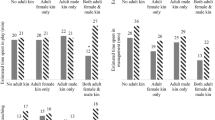Abstract
Public debate on same-sex marriage often focuses on the disadvantages that children raised by same-sex couples may face. On one hand, little evidence suggests any difference in the outcomes of children raised by same-sex parents and different-sex parents. On the other hand, most studies are limited by problems of sample selection and size, and few directly measure the parenting practices thought to influence child development. This research note demonstrates how the 2003–2013 American Time Use Survey (n = 44,188) may help to address these limitations. Two-tier Cragg’s Tobit alternative models estimated the amount of time that parents in different-sex and same-sex couples engaged in child-focused time. Women in same-sex couples were more likely than either women or men in different-sex couples to spend such time with children. Overall, women (regardless of the gender of their partners) and men coupled with other men spent significantly more time with children than men coupled with women, conditional on spending any child-focused time. These results support prior research that different-sex couples do not invest in children at appreciably different levels than same-sex couples. We highlight the potential for existing nationally representative data sets to provide preliminary insights into the developmental experiences of children in nontraditional families.

Similar content being viewed by others
References
Bianchi, S. (2010). Maternal employment and time with children: Dramatic change or surprising continuity? Demography, 37, 401–411.
Bianchi, S. (2011). Family change and time allocation in American families. ANNALS of the American Academy of Political and Social Science, 638, 21–44.
Biblarz, T. J., & Stacey, J. (2010). How does the gender of parents matter? Journal of Marriage and Family, 72, 3–22.
Black, D., Gates, G., Sanders, S., & Taylor, L. (2000). Demographics of the gay and lesbian population in the United States: Evidence from available systematic data sources. Demography, 37, 139–154.
Bureau of Labor Statistics. (2014). American Time Use Survey user’s guide: Understanding ATUS 2003 to 2013. Washington, DC: U.S. Department of Labor.
Burke, W. J. (2009). Fitting and interpreting Cragg’s Tobit alternative using Stata. Stata Journal, 9, 584–592.
Cole, E. R., Avery, L. R., Dodson, C., & Goodman, K. D. (2012). Against nature: How arguments about the naturalness of marriage privilege heterosexuality. Journal of Social Issues, 68, 46–62.
Cragg, J. G. (1971). Some statistical models for limited dependent variables with application to the demand for durable goods. Econometrica, 39, 829–844.
Crosnoe, R., & Cavanagh, S. (2010). Families with children and adolescents: A review, critique, and future agenda. Journal of Marriage and Family, 72, 594–611.
Crouch, S. R., Waters, E., McNair, R., Power, J., & Davis, E. (2014). Parent-reported measures of child health and wellbeing in same-sex parent families: A cross-sectional survey. BMC Public Health , 14, 635. doi:10.1186/1471-2458-14-635
Farr, R. H., Forssell, S. L., & Patterson, C. J. (2010). Parenting and child development in adoptive families: Does parental sexual orientation matter? Applied Developmental Science, 14, 164–178.
Garret, J. R., & Lantos, J. D. (2013). Marriage and the well-being of children. Pediatrics, 131, 559–563.
Gartrell, N., & Bos, H. (2010). US National Longitudinal Lesbian Family Study: Psychological adjustment of 17-year-old adolescents. Pediatrics, 126, 28–36.
Gates, G. (2009). Same-sex spouses and unmarried partners in the American Community Survey, 2008. Los Angeles, CA: The Williams Institute.
Giddings, L., Nunley, J. M., Schneebaum, A., & Zietz, J. (2014). Birth cohort and the specialization gap between same-sex and different-sex couples. Demography, 51, 509–534.
Joslin, C. (2011). Searching for harm: Same-sex marriage and the well-being of children. Harvard Civil Rights-Civil Liberties Law Review (CR-CL), 46, 81–101.
Kalil, A., Ryan, R., & Corey, M. (2012). Diverging destinies: Maternal education and the developmental gradient in time with children. Demography, 49, 1361–1383.
Lavner, J. A., Waterman, J., & Peplau, L. A. (2012). Can gay and lesbian parents promote healthy development in high-risk children adopted from foster care? American Journal of Orthopsychiatry, 82, 465–472.
McLanahan, S. (2004). Diverging destinies: How children are faring under the second demographic transition. Demography, 41, 607–627.
Potter, D. (2012). Same-sex parent families and children’s academic achievement. Journal of Marriage and Family, 74, 556–571.
Rivers, I., Poteat, V. P., & Noret, N. (2008). Victimization, social support, and psychosocial functioning among children of same-sex and opposite-sex couples in the United Kingdom. Developmental Psychology, 44, 127–134.
Rosenfeld, M. J. (2010). Nontraditional families and childhood progress through school. Demography, 47, 755–775.
Sanberg, J. F., & Hofferth, S. L. (2001). Changes in children’s time with parents: United States, 1981–1997. Demography, 38, 423–436.
Stewart, J. (2009). Tobit or not Tobit? (BLS Working Papers). Washington, DC: U.S. Bureau of Labor Statistics.
U.S. Census Bureau. (2014). 2014 census test: Questions. Retrieved from http://www.census.gov/programs-surveys/decennial-census/2020-census/research-testing/testing-activities/2014-census-test/questions.html
Wainright, J. L., Russell, S. T., & Patterson, C. J. (2004). Psychosocial adjustment, school outcomes, and romantic relationships of adolescents with same-sex parents. Child Development, 75, 1886–1898.
Acknowledgments
This research was supported by Grant 5 R24 HD042849, Population Research Center, and Grant 5 T32 HD007081, Training Program in Population Studies, awarded to the Population Research Center at The University of Texas at Austin by the Eunice Kennedy Shriver National Institute of Child Health and Human Development (NICHD).
Author information
Authors and Affiliations
Corresponding author
Appendix
Appendix
Rights and permissions
About this article
Cite this article
Prickett, K.C., Martin-Storey, A. & Crosnoe, R. A Research Note on Time With Children in Different- and Same-Sex Two-Parent Families. Demography 52, 905–918 (2015). https://doi.org/10.1007/s13524-015-0385-2
Published:
Issue Date:
DOI: https://doi.org/10.1007/s13524-015-0385-2




